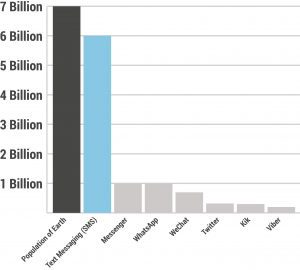Last year we were telling brands to keep an eye out for trends in messaging. This year, brands are trying their best to deliver an omnichannel experience across the growing array of customer channels and touchpoints. Through a culmination of research, anecdotal experience, and interviews with customer service leaders from top global brands, here is our take on the biggest customer service trends than every customer-centric business should watch for.
Let’s first look at the state of messaging. There are more than 7 billion people on Earth, and more than 6 billion smartphones. Text messaging is default installed on every single one of them. Let’s compare texting to platforms like Facebook and WeChat.

Text messaging remains the number one messaging platform in North America. Every day billions of texts are sent, and today millions of those are from customers texting with customer service. Snapchat may not be as big, but it’s coming, and we bet it will be bigger than Messenger. You need to be on it.
Messenger isn’t exactly a new platform. However, Facebook’s big miss in 2016 with bots caused brands to pause before eliminating humans and trusting machines. Keep an eye on Messenger for human-to-human, though, because it’s incredibly fast and efficient
for customer service.
Trends to Watch
Single devices take over: Rest in peace, tablets. Although they still serve a great number of customers, the phone sizes in today’s market are so large they are becoming the single device consumers use for Internet. That means they aren’t switching between a ton of devices, just using that one giant smartphone.
Takeaway: Spend less time designing for mobile+tablet+desktop and more time just on mobile. Mobile first was a buzzword in 2016, but it’s an essential in 2017.
Less social posting, more reading: Social is not dead. Those millions of followers that brands pay to engage with are still valuable. However, their individual engagement is down. A recent Fortune article points out that sharing is down 21%–a massive drop from the year before. Reading, however, went up by 65%.
Takeaway: Stop counting engagement like it matters. Likes and comments are relics of times past. Today, the important metric is views, plays, and conversations–two metrics from video, and one from 1:1 audience engagement on Messenger.
Messaging is bigger than social: Messaging is officially here. In 2015, the number of consumers messaging on a daily basis surpassed 3 billion. That number continues increasing every day, and messaging will have twice the audience size of social media by the end of 2018.
Takeaway: If you don’t have a messaging strategy to talk human to human with customers, you are missing an opportunity to be ahead of the curve and create a lasting bond with
customers.
Bots are dead: In April 2016 Facebook announced the ability to create bots for their
messenger platform. Less than one year and millions of terrible bot experiences and they are officially pulling back their push for humans to talk to computers.
Takeway: Bots can be helpful in the right context. However, this novelty proved to be more harmful than helpful. It hurt brand affinity, increased inbound tickets to customer service, and proved that brands can still fall for gimmicks.
Video takes the cake: Consumption of video continues to skyrocket. Viewing habits have
shifted from cable/TV to video clips on mobile devices. A new era of celebrities from streaming services are emerging, and brands are taking full advantage of these more affordable, more-authentic personalities.
Takeaway: If you don’t have a creator studio to make entertaining clips, it’s time to
invest in some lights and a good camera. Video, like messaging, is here to stay and it’s up to brands to catch up to the consumer trend.
What to do today
So in light of these trends, how can businesses build a mobile-first approach to customer service?
Firstly, go be your own customer. Get out of the office and go be your own customer. If you work for CPG, go to a store and ask customers what their day looks like, what apps they use, and how they communicate with their friends and family. Then, mimic their behavior to better understand not just what their day looks like, but why it looks that way.
Then, write out exactly what your customer journey looks like, using Post-Its for each step of the journey. Then, review with your team the different pain points your customers have today. For a global brand, narrow it down to a region before diving into global patterns. Wherever you determine a pain points needs help, think about where the customer is already at digitally, then meet them there. Rearrange the post its in random order and see if your solutions still help.
What are your top-of-mind customer experience issues? I’d be interested in your thoughts.



